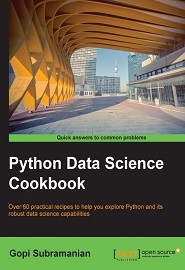
English | 2015 | ISBN: 978-1784396404 | 347 Pages | EPUB | 10 MB
Python is increasingly becoming the language for data science. It is overtaking R in terms of adoption, it is widely known by many developers, and has a strong set of libraries such as Numpy, Pandas, scikit-learn, Matplotlib, Ipython and Scipy, to support its usage in this field. Data Science is the emerging new hot tech field, which is an amalgamation of different disciplines including statistics, machine learning, and computer science. It’s a disruptive technology changing the face of today’s business and altering the economy of various verticals including retail, manufacturing, online ventures, and hospitality, to name a few, in a big way.
This book will walk you through the various steps, starting from simple to the most complex algorithms available in the Data Science arsenal, to effectively mine data and derive intelligence from it. At every step, we provide simple and efficient Python recipes that will not only show you how to implement these algorithms, but also clarify the underlying concept thoroughly.
The book begins by introducing you to using Python for Data Science, followed by working with Python environments. You will then learn how to analyse your data with Python. The book then teaches you the concepts of data mining followed by an extensive coverage of machine learning methods. It introduces you to a number of Python libraries available to help implement machine learning and data mining routines effectively. It also covers the principles of shrinkage, ensemble methods, random forest, rotation forest, and extreme trees, which are a must-have for any successful Data Science Professional.
What You Will Learn
- Explore the complete range of Data Science algorithms
- Get to know the tricks used by industry engineers to create the most accurate data science models
- Manage and use Python libraries such as numpy, scipy, scikit learn, and matplotlib effectively
- Create meaningful features to solve real-world problems
- Take a look at Advanced Regression methods for model building and variable selection
- Get a thorough understanding of the underlying concepts and implementation of Ensemble methods
- Solve real-world problems using a variety of different datasets from numerical and text data modalities
- Get accustomed to modern state-of-the art algorithms such as Gradient Boosting, Random Forest, Rotation Forest, and so on
Resolve the captcha to access the links!